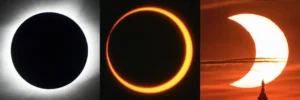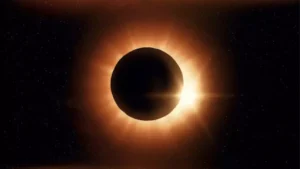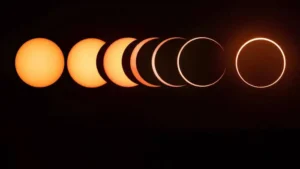“Witness the Spectacular 2023 Annular Solar Eclipse: A Celestial Extravaganza!”.The enchanting “ring of fire” is set to grace the skies of the Western Hemisphere this upcoming weekend, and it’s an event you won’t want to miss. Millions of people are eagerly anticipating this latest celestial marvel, an annular solar eclipse that will adorn our celestial canvas. In this article, we’ll take you on a journey through this mesmerizing phenomenon as it unfolds in various regions.
On the morning of Saturday, a breathtaking spectacle will begin in Oregon, marking the start of the “ring of fire” eclipse’s journey. This celestial phenomenon will then sweep its way across the American Southwest, leaving a trail of awe-inspired gazers in its wake as it exits the United States through Texas.
As it continues its path, it will cut through the lush landscapes of the Yucatán Peninsula in Mexico, casting its ethereal glow over a number of Central American countries. The journey doesn’t stop there; this celestial traveler will make its way to South America, where it will pass through the skies of Colombia and Brazil, leaving a trail of wondrous memories. Its final bow will be taken over the vast expanse of the Atlantic Ocean.
As we delve into the wonder of this celestial event, we’d like to emphasize a crucial safety point: Never look directly at a partial eclipse. Safeguard your vision by wearing protective eyewear or utilizing alternative viewing methods.
Prepare yourself for a cosmic experience that promises to be nothing short of magical. The 2023 annular solar eclipse is a celestial extravaganza waiting to unfold. So, mark your calendars, gather your eclipse-watching gear, and get ready to witness a remarkable display in the heavens.
Unveiling the Celestial Dance: Solar Eclipses and the Spectacle of Light and Shadow

Solar eclipses, those rare and captivating cosmic events, have fascinated humankind for centuries. It’s a celestial dance that occurs when the moon takes its special position between the sun and our planet, momentarily cloaking the sun from our view.
In those awe-inspiring moments, part of the Earth finds itself bathed in lunar shadow, transforming the bright day into a twilight spectacle. This article delves into the enchanting world of solar eclipses, exploring why these celestial alignments happen and how they create moments of wonder in the sky.
At the heart of a solar eclipse lies a remarkable cosmic coincidence. While the sun is indeed approximately 400 times larger than the moon, it also happens to be about 400 times farther from Earth. This unique alignment results in the sun and the moon appearing almost the same size when viewed from our planet. It’s as though nature herself has orchestrated a perfect optical illusion, filling our sky with wonder.
Adding to this cosmic spectacle is the moon’s elliptical orbit. It’s not a perfect circle but a slightly stretched oval. This eccentricity plays a crucial role in the diversity of solar eclipses. An annular solar eclipse, for instance, takes place when the moon is at its farthest point from Earth, known as apogee.
At this moment, the moon appears just slightly smaller than the sun, and during the peak of this eclipse, we witness a breathtaking sight – a golden halo encircling the moon, often referred to as the “ring of fire.”
On the flip side, when the moon finds itself closer to Earth, a total solar eclipse occurs. During these extraordinary moments, the moon entirely obscures the sun, casting a blanket of darkness upon the land. The sky transforms into night, and stars make an early appearance. It’s a breathtaking experience that leaves us in awe of the cosmos.
An annular solar eclipse, on the other hand, offers a unique perspective. The sky doesn’t turn pitch black but dims to resemble the enchanting hues of dusk. The world takes on a surreal, almost dreamlike quality as we witness the “ring of fire” encircling the moon.
In Conclusion, Solar eclipses are captivating reminders of the wonders of our universe. These celestial events connect us to the cosmic rhythms that have shaped our world for eons.
Whether you’re gazing up in wonder or simply appreciating the intricate dance of celestial bodies, solar eclipses offer moments of awe, wonder, and a profound connection to the cosmos. So, mark your calendars and prepare to be enthralled by the next celestial spectacle gracing our skies.

Chasing Shadows: Discovering the Prime Eclipse Viewing Spots Across the Americas
The anticipation is building as we gear up for the celestial spectacle of the year—an annular solar eclipse. To make the most of this awe-inspiring event, you need to be in the right place at the right time.
In this article, we unveil the prime locations along the eclipse’s path where you can witness the magic of the moon’s shadow as it momentarily cloaks the sun. From the United States to distant shores, we’ll guide you to the perfect spots for your front-row seat to this celestial extravaganza.
The path of annularity is where the eclipse takes center stage, casting its enchanting shadow over select locations. The New York Times has generously provided a map that outlines the approximate trajectory of the solar eclipse.
For those within or near this path, here are some standout cities in the United States to consider: Eugene, Oregon; Ely and Battle Mountain in Nevada; Richfield, Utah; Roswell and Albuquerque in New Mexico; and Texas gems like Midland, San Antonio, and Corpus Christi.
For those yearning for an extraordinary experience, look no further than these remarkable American landmarks along the eclipse’s path of annularity. Crater Lake in Oregon, the ancient wonders of Chaco Canyon in New Mexico, and the captivating Lava Beds National Monument in California offer stunning backdrops for this cosmic drama.

The celestial wonder doesn’t stop at the U.S. border. Beyond American soil, international cities are poised to witness annularity in all its splendor. In Mexico, locations like Campeche and Chetumal will have a front-row seat. As we venture further south, Belize City in Belize, Olanchito in Honduras, Cali in Colombia, and Brazilian gems Tefé and João Pessoa will also share in this celestial dance.
In Conclusion, the 2023 annular solar eclipse is an event of a lifetime, and selecting the perfect vantage point is key to an unforgettable experience. Whether you choose to explore the natural wonders of the United States or venture into international territories, remember to prepare for this cosmic rendezvous.
Mark your calendars and set your sights on the prime eclipse viewing spots. An adventure of celestial proportions awaits, promising unforgettable memories and a connection with the universe.
Shadows and Splendor: The Widespread Eclipse Experience Across Major Cities
The anticipation for the upcoming annular solar eclipse is palpable, and while the path of annularity is captivating, the celestial spectacle isn’t limited to select locations.
Major cities across the Americas are gearing up to experience a significant partial eclipse, promising a mesmerizing play of light and shadow in the sky. In this article, we take you on a journey to cities that will be touched by this cosmic event, sharing the wonder with millions.
While the path of annularity holds its own allure, many major cities outside this trajectory are poised to witness a significant partial eclipse. In the United States, cities like Seattle, Los Angeles, Las Vegas, and Houston will all experience a remarkable celestial show.
Meanwhile, our neighbors to the south are in for a treat too, with Mexico City, the vibrant capital of Mexico, joining the eclipse party. The magic extends further south to Bogotá in Colombia, Rio de Janeiro in Brazil, and Tegucigalpa in Honduras, where the celestial wonder will paint the skies with its splendor.
To make this celestial journey even more immersive, The Times and its dedicated reporters are on a mission to bring you dispatches from various locations along the eclipse’s route. From the heart of the United States to captivating sites across Latin America, our team will capture the essence of this celestial phenomenon.
Through their eyes and words, you’ll embark on a virtual expedition, gaining insights and experiencing the eclipse as if you were there in person.
In Conclusion, The 2023 annular solar eclipse transcends boundaries, offering its spectacle to major cities far and wide. Whether you’re in a prime location within the path of annularity or joining the excitement of a partial eclipse, the wonder of this cosmic event is undeniable.
Prepare to be part of this celestial journey, and follow The Times’ coverage for a firsthand experience of this extraordinary celestial display. The cosmos beckons, and you’re invited to be part of this grand spectacle of shadows and splendor.
A Celestial Odyssey: Tracing the Path of the 2023 Annular Solar Eclipse
The cosmos is preparing for a mesmerizing spectacle as the 2023 annular solar eclipse sets off on its celestial journey. In the predawn hours, this celestial dance begins over the vast Pacific Ocean, 1,200 miles northwest of the U.S. mainland.
As the day unfolds, the shadow of the moon will grace various parts of the world, creating moments of wonder and celestial grandeur. Join us as we follow the eclipse’s path and explore the magic it brings across continents.
The celestial show commences with a partial solar eclipse, painting the skies of Oregon with its first brushstrokes as early as 11:05 a.m. Eastern time. Annularity takes center stage around 12:16 p.m., embarking on a sweeping journey across the nation that will last for the next couple of hours.
The sun’s halo will kiss the Texas coastline at around 12:58 p.m. Eastern time before making its grand entrance into Mexico at 1:21 p.m. From there, the celestial journey continues, crossing over Central and South America for over two mesmerizing hours. Finally, the grand finale unfolds on the captivating coast of Brazil at 3:48 p.m. Eastern time, leaving an indelible mark in the sky.
The duration of the annular eclipse is a celestial gift that varies based on your location. For those along the coast of Texas, the sun will wear its halo for a breathtaking five minutes.
However, the celestial crown shines the longest over the Nicaraguan and Panamanian coasts, where the showstopping display will grace the skies for about five minutes and 15 seconds, making it a truly unforgettable experience.
In Conclusion, The 2023 annular solar eclipse promises to be an unforgettable celestial journey, painting the skies with moments of wonder, grandeur, and fascination. Whether you’re on the U.S. coast, across the Mexican landscapes, or beneath the South American heavens, the eclipse offers a chance to connect with the universe in a unique way.
Mark your calendars, gather your eclipse-watching gear, and set your sights on the skies. The celestial odyssey awaits, inviting you to be part of a grand spectacle that transcends time and place.
Eclipse Magic for All: A Glimpse of the 2023 Annular Solar Eclipse and Livestream Adventures
As the 2023 annular solar eclipse embarks on its celestial journey, millions of eyes will be gazing upwards, eager to catch a glimpse of this cosmic spectacle. For those not within the path of annularity, a magical experience still awaits.
Join us as we explore the wonder of a partial solar eclipse, where only a portion of the sun is veiled by the moon, creating a mesmerizing glowing crescent in the sky. We’ll also unveil the key to unlocking the celestial show through live streaming events. The universe has something in store for everyone.
Outside the path of annularity, the moon’s shadow paints a celestial masterpiece. During a partial solar eclipse, only a part of the sun is hidden, casting a radiant gold crescent across the sky.
The level of coverage varies as you move away from the path of annularity, with the sun’s surface becoming increasingly visible. It’s a breathtaking experience, offering a captivating play of light and shadow that enchants all who witness it.
If you find yourself in a location where weather or other factors prevent you from experiencing the eclipse in person, fear not. The cosmos is within your reach through a virtual journey. Several esteemed organizations, including NASA, Time and Date, the San Francisco Exploratorium, and the renowned Lowell Observatory in Arizona, are your guides to a live streaming adventure.
They will bring the celestial show right to your screens, offering an up-close view of the annular eclipse. You can be part of this cosmic voyage from the comfort of your own space.
In Conclusion, The 2023 annular solar eclipse is a celestial gift that extends its magic to all corners of the Earth. Whether you’re basking in the glow of a partial eclipse or embarking on a virtual cosmic adventure, the universe invites you to be part of this grand spectacle.
Mark your calendars, set your devices, and prepare to be enchanted by the wonders of the cosmos. The eclipse is a reminder that, no matter where you are, the universe has a way of bringing its magic to your doorstep.
Eclipse Safety: How to Witness the 2023 Annular Solar Eclipse without Harm
The 2023 annular solar eclipse is a celestial event of grand proportions, but it comes with a caution: never gaze directly at the sun during an eclipse without the proper protection.
In this article, we’ll explore the safest ways to witness this cosmic spectacle, ensuring that your eyes remain unharmed and your experience unforgettable. From affordable paper eclipse glasses to DIY pinhole projectors, we’ve got your eclipse viewing options covered.
One of the most popular and budget-friendly choices for safe eclipse viewing is to grab a pair of paper eclipse glasses. These specially designed glasses effectively filter out the sun’s harmful radiation, allowing you to observe the eclipse without risk.
To ensure your safety, check for reputable vendors listed by the American Astronomical Society before making a purchase. Avoid damaged eclipse glasses or those that may have been around since the 2017 Great American Eclipse, as suggested by NASA.
For those who seek a closer look, eclipse viewers with magnification are a fantastic option. They not only provide protection but also enhance your view of the sun’s mesmerizing journey. These viewers offer an opportunity to appreciate the celestial dance with added clarity and detail.
Stepping up in viewing quality and investment, consider binocular or telescope filters. These filters provide an up-close encounter with the eclipse, bringing out intricate details in the sun’s halo. They offer a view that’s nothing short of enchanting, transforming the celestial event into an even more spectacular experience.
If specialized gear is out of reach, don’t fret. You can still enjoy the eclipse safely by using a pinhole camera. It can be as simple as creating a crisscross pattern with your fingers or punching a hole in an index card.
This DIY approach projects an image of the eclipse onto the ground, allowing you to witness the celestial phenomenon indirectly. For a more sophisticated option, you can craft a box pinhole projector using readily available household items, offering a memorable and safe eclipse viewing experience.
In Conclusion, Safety is paramount when it comes to eclipse viewing, and there are options for everyone to witness the 2023 annular solar eclipse securely. Whether you choose the affordability of eclipse glasses, the enhanced view of magnified eclipse viewers, or the in-depth encounter of binocular and telescope filters, remember that the cosmos invites all to partake in its wonder.
Prepare for the celestial spectacle responsibly, protect your eyes, and relish the celestial magic that unfolds. The universe beckons, and you’re invited to be part of this grand celestial performance.
Celestial Theater: Unraveling the Stages of the 2023 Annular Solar Eclipse
The universe is set to unveil a celestial drama of grand proportions, and you’re invited to the front row. The 2023 annular solar eclipse promises a cosmic performance that unfolds in distinct stages. Join us as we demystify the intricacies of this celestial spectacle, offering an opportunity for everyone to be part of this awe-inspiring event.
The opening act of this celestial theater is the partial solar eclipse. It’s a gentle beginning as the moon takes its first step to engulf the surface of the sun. Known as “first contact,” this phase sets the stage and lasts for approximately one hour and 20 minutes, offering a gradual introduction to the cosmic ballet.
The spotlight shines brightest during the annular phase, where the sun takes on the appearance of a radiant ring of fire in the sky. Here, around 90 percent of the solar surface is concealed by the moon. The duration of this breathtaking phase varies depending on your viewing location, lasting from one to five magical minutes.
As the sun’s brilliance transforms into a dazzling ring, the world around you will undergo a mesmerizing transformation. The sky darkens, animals might respond to the sudden change, and even plants may react to the celestial spectacle.
As the moon begins its graceful departure from the sun, we enter the third contact phase. This part of the cosmic journey spans another one hour and 20 minutes, offering a lingering taste of the eclipse’s magic. It’s a gentle transition, a reminder of the cosmic performance’s ebb and flow.
The grand finale arrives at the fourth contact, when the sun fully reemerges, signaling the eclipse’s end. It’s a moment of transition, a return to the familiar light of day, and a reminder of the wonders of the universe.
In Conclusion, The 2023 annular solar eclipse is a multi-act spectacle that promises to enchant all who witness it. The beauty of these stages lies not only in their celestial grandeur but in the opportunity they provide for everyone to connect with the cosmos.
Mark your calendars, prepare your eclipse-watching gear, and set your sights on the skies. The universe’s celestial theater is ready to dazzle, and you’re an integral part of the audience. The cosmic drama awaits, and the curtain is about to rise.
Cosmic Marvels: The Rare Dance of Sun, Moon, and Earth in Solar Eclipses
The universe has a way of captivating our imagination with its celestial ballets, and one of the most enchanting performances is the solar eclipse. According to NASA, the stars of this show – the sun, moon, and Earth – align for a total or annular solar eclipse only twice a year.
Yet, these cosmic events often play out in remote parts of the world or over vast bodies of water, making them challenging to observe. In this article, we delve into the rarity of solar eclipses, recent moments in the spotlight, and future opportunities for celestial gazing.
For those residing in the United States, solar eclipse memories are etched in the sky. The last annular eclipse graced American shores in 2012, while the nation collectively looked up in awe during the last total solar eclipse in 2017. These events brought people together to witness the cosmic spectacle and left an indelible mark on their memories.
If you happen to miss the upcoming annular eclipse, don’t fret; there’s another celestial journey just around the corner.
Next April, a total solar eclipse will cast its spell over North America, starting in Mexico, traveling through the Eastern half of the United States, and concluding its mesmerizing display in Canada. This cross-continental eclipse promises to be a visual feast for all who seek it.
However, it’s worth noting that after 2024, the anticipation will build for the next solar eclipse in the United States, which won’t grace the skies until 2041.
As we count down the years, the rarity and magic of these cosmic events become even more apparent, reminding us of the need to savor every moment under the celestial spectacle.


